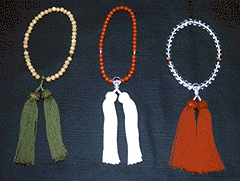 |
 |
Juzu (Buddhist rosary)
 Juzu, a famous product of Kyoto from long ago, came into Japan along with the transmission of Buddhism, though it was not widespread among Buddhist lay followers until the Meiji period. Each bead has a meaning and the way they are strung together also has deep philosophical significance. The form may vary depending on the sect and even within the same sect, priests and nuns may have a different one from those of the lay members. Moreover, its use may vary depending on time and place. The basic number o f beads is 108 but this number can range from as little as 14 to as many as 1080 beads. Most of the juzu are made in Kyoto, where most of the head temples of various Buddhist sects are located. Often, the beads are made mostly in areas such as Izumi City and Omi Hachiman, where craftsmen string them together and attach a tassle, however, originally the tassle was not merely attached but was used to string the rosary together. In Kyoto, this tassle became highly developed in the Nishijin textile area and the craft of this twisted thread came to be used to create the exquisite Buddhist rosaries of Kyoto. Juzu, a famous product of Kyoto from long ago, came into Japan along with the transmission of Buddhism, though it was not widespread among Buddhist lay followers until the Meiji period. Each bead has a meaning and the way they are strung together also has deep philosophical significance. The form may vary depending on the sect and even within the same sect, priests and nuns may have a different one from those of the lay members. Moreover, its use may vary depending on time and place. The basic number o f beads is 108 but this number can range from as little as 14 to as many as 1080 beads. Most of the juzu are made in Kyoto, where most of the head temples of various Buddhist sects are located. Often, the beads are made mostly in areas such as Izumi City and Omi Hachiman, where craftsmen string them together and attach a tassle, however, originally the tassle was not merely attached but was used to string the rosary together. In Kyoto, this tassle became highly developed in the Nishijin textile area and the craft of this twisted thread came to be used to create the exquisite Buddhist rosaries of Kyoto.
BACK


|
|